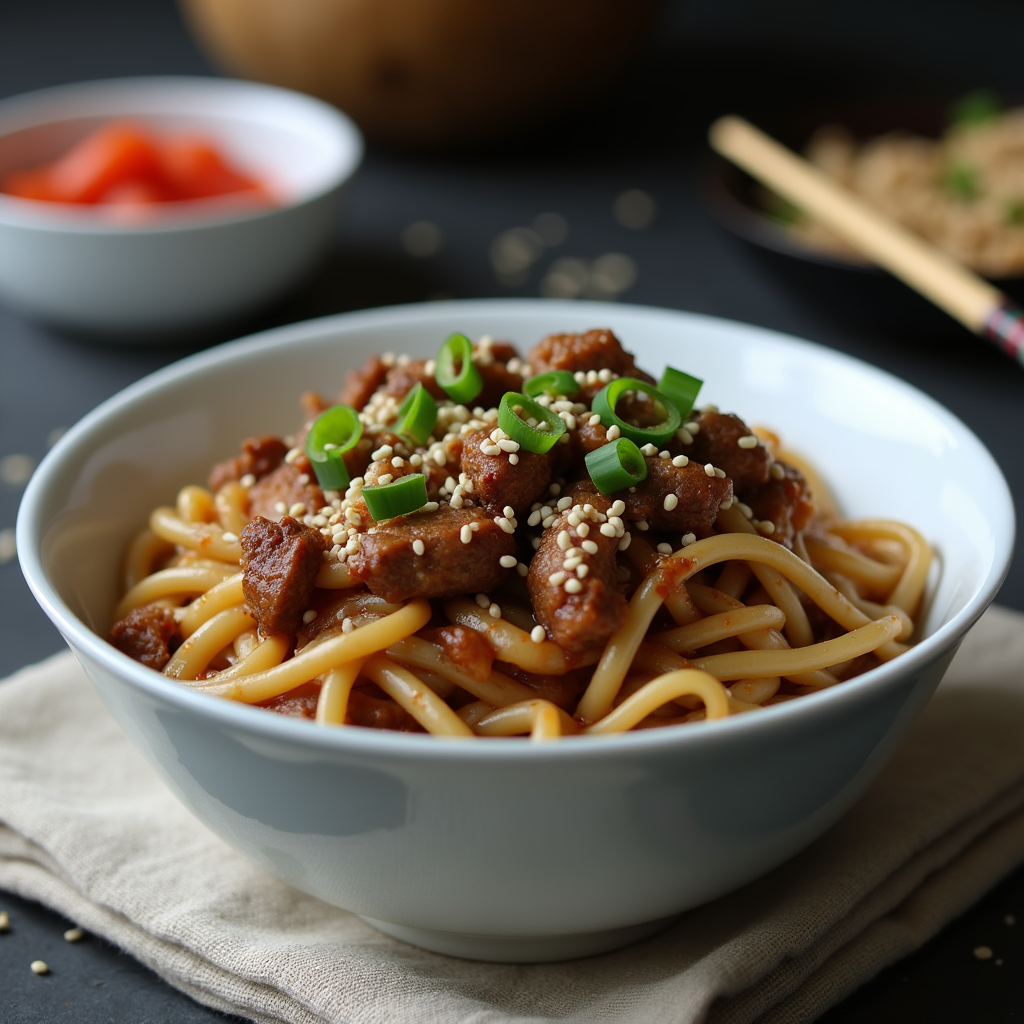Mongolian Ground Beef Noodles are a delicious and satisfying dish that combines the perfect balance of sweet, savory, and umami flavors. This quick and easy recipe is ideal for busy weeknights, offering a comforting meal that the whole family will love.
In this guide, we’ll provide a detailed, step-by-step approach to making Mongolian Ground Beef Noodles, complete with ingredient substitutions, cooking techniques, and expert tips to elevate your cooking experience. Whether you’re a beginner or an experienced cook, this dish is simple to prepare yet bursting with bold flavors.
What are Mongolian Ground Beef Noodles?
Mongolian Ground Beef Noodles are a budget-friendly and time-saving variation of the classic Mongolian beef dish. Instead of using sliced beef, ground beef is cooked in a rich, flavorful sauce made from soy sauce, brown sugar, garlic, and ginger. The sauce thickens to coat the beef and noodles, creating a hearty, satisfying meal with a delightful texture and taste.
Origins of Mongolian Beef and Noodles
Despite its name, Mongolian beef does not originate from Mongolia. It is a Chinese-American dish that gained popularity due to its sweet-savory sauce and tender beef. Over time, different adaptations emerged, such as Mongolian Ground Beef Noodles, offering a simpler and quicker take on the traditional recipe.
Ingredients for Mongolian Ground Beef Noodles
Essential Ingredients:
- Ground Beef – Lean ground beef is ideal to maintain flavor without excess grease.
- Noodles – Lo mein, ramen, or spaghetti work well to absorb the sauce.
- Soy Sauce – A crucial component for umami depth; low-sodium soy sauce helps balance flavors.
- Brown Sugar – Adds sweetness to complement the savory elements.
- Garlic and Ginger – Key aromatics that enhance the dish’s flavor profile.
- Cornstarch – Thickens the sauce for better coating.
- Scallions and Sesame Seeds – Used for garnish to add freshness and a slight crunch.
Substitutes and Dietary Modifications:
- Protein Alternatives: Use ground turkey, chicken, or tofu instead of beef.
- Gluten-Free: Replace soy sauce with tamari and use rice noodles.
- Low-Carb: Substitute noodles with zucchini noodles or spaghetti squash.
- Vegetarian: Swap beef for mushrooms, bell peppers, or snap peas.
How to Make Mongolian Ground Beef Noodles
Step 1: Prepare the Noodles
- Cook the noodles according to the package instructions, draining them slightly early to prevent overcooking.
- Toss with a small amount of sesame oil to prevent sticking.
Step 2: Cook the Ground Beef
- Heat a large skillet or wok over medium-high heat with a tablespoon of oil.
- Add the ground beef and cook until browned, breaking it apart as it cooks.
- Drain excess grease if necessary.
Step 3: Make the Mongolian Sauce
- In a bowl, mix ½ cup soy sauce, ½ cup brown sugar, 2 tablespoons cornstarch, 1 tablespoon grated ginger, and 2 minced garlic cloves.
- Stir until smooth, ensuring the cornstarch dissolves completely.
- Pour the sauce into the skillet with the beef, stirring for 2-3 minutes until it thickens.
Step 4: Combine Everything
- Add the cooked noodles to the skillet and toss until evenly coated in the sauce.
- Taste and adjust seasoning if needed by adding more soy sauce or brown sugar.
- Garnish with scallions and sesame seeds before serving.
Tips for the Best Mongolian Ground Beef Noodles
Perfecting the Texture of Your Noodles
- Slightly undercook noodles, as they will continue to absorb sauce while mixing.
- Use fresh lo mein noodles for the best texture.
- Toss noodles with oil to prevent them from clumping.
Balancing the Flavors of Mongolian Sauce
- Taste the sauce before adding it and adjust the flavors as needed.
- Enhance depth by adding hoisin or oyster sauce.
- If you like spice, mix in chili paste, red pepper flakes, or Sriracha.
Common Cooking Mistakes to Avoid
- Overcrowding the Pan: Cook beef in batches to ensure proper browning.
- Overheating the Sauce: Keep heat at medium to prevent burning the sugar.
- Skipping the Garnish: Scallions and sesame seeds enhance both flavor and presentation.
Storage and Reheating Tips
How to Store Mongolian Ground Beef Noodles
- Refrigerate: Store in an airtight container for up to 3-4 days.
- Freeze: Store in freezer-safe containers for up to 3 months. Freezing the noodles and beef separately provides better texture upon reheating.
Best Ways to Reheat
- Microwave: Heat in 2-minute intervals, stirring in between.
- Stovetop: Reheat over medium heat with a splash of water or soy sauce.
- Avoid Overcooking: Be cautious not to overheat, as the noodles may become mushy.
Creative Variations to Try
Vegetarian and Vegan Options
- Replace ground beef with plant-based crumbles or tofu.
- Increase vegetable content with mushrooms, carrots, and snap peas.
- Swap soy sauce for tamari and brown sugar for maple syrup for a vegan-friendly twist.
Spicy Mongolian Ground Beef Noodles
- Add chili paste, sambal oelek, or Sriracha.
- Sauté red chilies or jalapeños with the beef.
- Sprinkle red pepper flakes or drizzle chili oil on top before serving.
Low-Carb & Gluten-Free Twists
- Use rice noodles or spaghetti squash instead of wheat-based noodles.
- Thicken the sauce with arrowroot powder instead of cornstarch.
Serving Suggestions
Best Side Dishes to Pair with Mongolian Ground Beef Noodles
- Steamed Vegetables: Broccoli, bok choy, or stir-fried snap peas.
- Asian-Inspired Salads: Cucumber salad or Asian slaw.
- Spring Rolls: Serve crispy vegetable or shrimp spring rolls as an appetizer.
Perfect Drink Pairings
- Green Tea: A refreshing contrast to the dish’s bold flavors.
- Light Beer or Sake: Complements the savory taste.
- Ginger Ale or Sparkling Water: Provides a fizzy palate cleanser.
Frequently Asked Questions
How long do Mongolian Ground Beef Noodles last?
They stay fresh for up to 4 days in the refrigerator and 3 months in the freezer.
Can I use a different type of meat?
Yes! Ground turkey, chicken, or even pork make excellent substitutes.
What’s the best noodle for this dish?
Lo mein is preferred, but ramen or spaghetti also work well.
Conclusion
Mongolian Ground Beef Noodles are a quick, delicious way to enjoy bold Asian flavors with minimal effort. Whether for a weeknight dinner or meal prep, this dish is versatile, satisfying, and packed with flavor. Experiment with different variations, pair with tasty sides, and enjoy a homemade twist on a takeout favorite!

